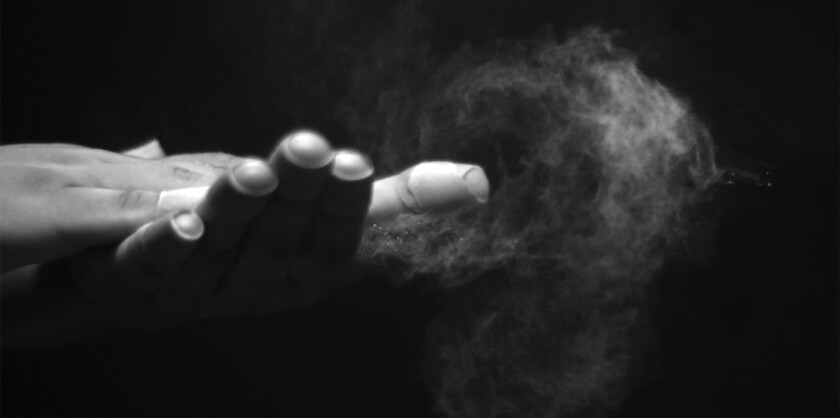What do you do with 30,000 photographs?

Zoe Adams.
Photo by Kendall McLaren
Zoe Adams interned with the Niels Bohr Library & Archives (NBLA) this past summer, working with a collection of born-digital photographs donated by the American Astronomical Society (AAS). She is currently entering her second year in the Master of Library and Information Science (MLIS) program at the University of Maryland, where she is concentrating in Archives and Digital Curation. She was first introduced to archives work at the Center for American War Letters Archives while attending Chapman University in California as an undergraduate. She fell in love with processing and describing collections as she marveled in creating order, leading her to pursue library science as a career.
In this post, Zoe tells us about the rewards, challenges, and value of her internship, which focused on preparing photographs for ingest into NBLA’s online repository
Last year, AAS donated over 30,000 born-digital photographs of member meetings from 2010 to 2024 to NBLA. This donation allowed NBLA to expand its collection of contemporary, born-digital photographs, showcasing the human side of science. However, due to the large volume of this donation and scarcity of space and resources - this unprocessed donation was the size of all of the previously existing photos on the repository combined - not every photograph could be kept by AIP and accessioned into the permanent collection. Thus, my task was to appraise the photographs, and, using a developing set of criteria, select which to download and add to the collection. I then extracted embedded metadata and reformatted it for ingest into the online repository.

Speaker Amy Kalili delivers a Plenary Lecture, “The Stewardship of Maunakea’s Legacy from the Perspective of the Hawaiian and Astronomical Communities,” at the American Astronomical Society’s (AAS) 235th meeting in January 2020.
Photo by CorporateEventImages/PhilMcCarten 2020, courtesy of AIP Emilio Segrè Visual Archives, American Astronomical Society Collection. Catalog ID: ph2024-2945_001_045_d
This project was a real exercise in learning as you go and allowing the process to evolve and change. I encountered a few challenges over the course of the project that forced us to consider several archival principles and the best courses of action.
The photographs were shared with us by AAS on SmugMug and organized by biannual meeting. The meeting albums were sorted into categories, such as “Invited Talks” and “Workshops,” and some photos were given captions. My supervisor, Archivist Elizabeth Wood
The goal was to select photographs to show a comprehensive yet representative idea of the meetings, including key figures and events. We focused specifically on highlighting award winners, keynote speakers, special performances and events, and group gatherings.

Attendees during the Grad School & REU Fair reception at the AAS’s 241st meeting at the Seattle Convention Center in 2023.
Photo by CorporateEventImages/Todd Buchanan, courtesy of AIP Emilio Segrè Visual Archives, American Astronomical Society Collection. Catalog ID: ph2024-2950_001_006_d
However, we soon discovered that not every meeting was structured and photographed in the same way. Especially when I reached the older meetings, it no longer made sense to treat the appraisal of the collection the same. I then needed to adjust my standards and method for selecting photos.
For example, our initial goal was to keep about 5-7% of each meeting. The album for the January 2024 meeting included 2,866 photos. We opted to keep 173 of those, making our percentage kept 6.1%. Some meetings, however, had many fewer photos provided by AAS. The meeting from May of 2011 only had 54 total photos, with us opting to keep 48 of them, meaning the percentage kept was 88.9%.
Another consideration in this project is maintaining original order while also following a metadata standard. I pulled embedded metadata directly from SmugMug without changing it, except for any spelling errors or mislabeling. However, this means that the metadata for this collection will look different than metadata created by NBLA staff for other collections. Archivist Allison Buser and I discussed creating a note about this difference to inform any researcher or future archivist that might be confused by the change in metadata structure.

Sample of SmugMug metadata. Left side is Title, right is Description. Both the titles and descriptions are longer and more formulaic than typical ESVA metadata.
Prior to this experience, I had never worked on the appraisal side of archives, only ever processing, rehousing, and describing. It was really interesting to work on this project and make the decisions about what items to keep in an archival collection. I found it challenging and intimidating at first to have the say in what photos are kept, but as I got further into the project, it became easier. The thing I kept going back to is considering the audience: who has a stake in these photos? Who will look for them and use them? In reminding myself what archives are for and why we work to make things accessible, I was able to find and select excellent photos that highlight the American Astronomical Society’s members and their mission.

Chambliss presenters at the American Astronomical Society’s 235th meeting in 2020.
Photo by CorporateEventImages/Todd Buchanan, courtesy of AIP Emilio Segrè Visual Archives, American Astronomical Society Collection. Catalog ID: ph2024-2945_001_106_d



